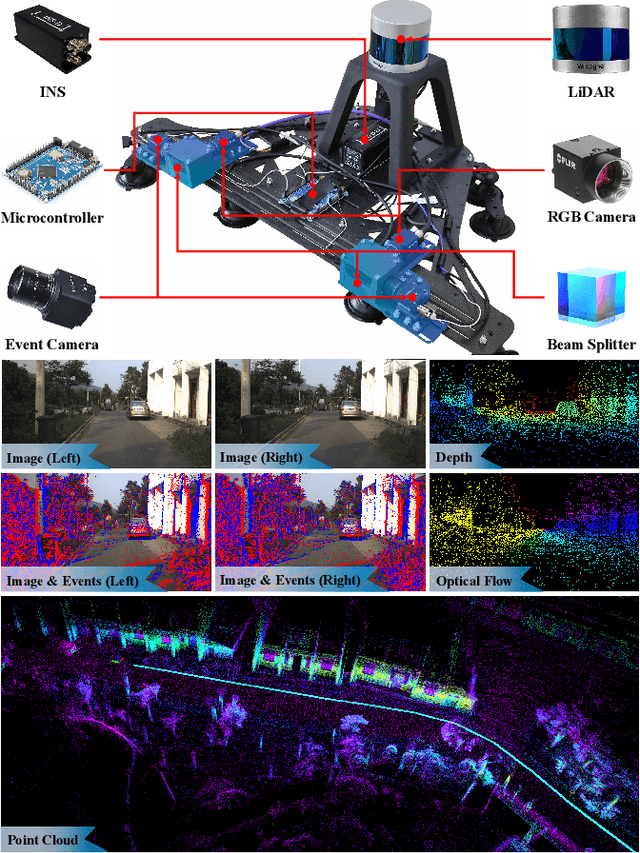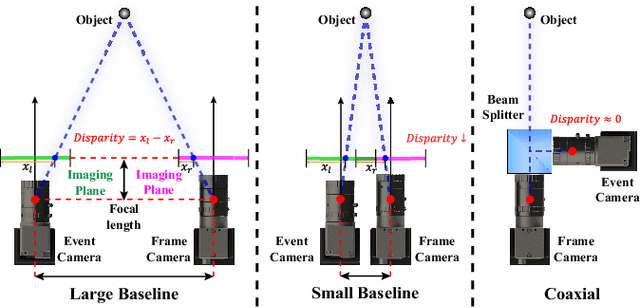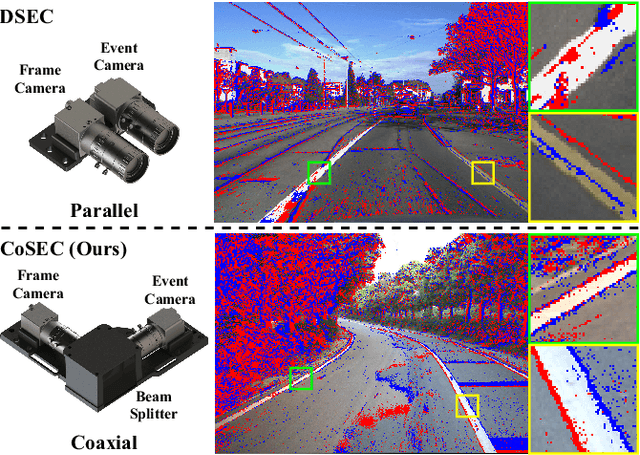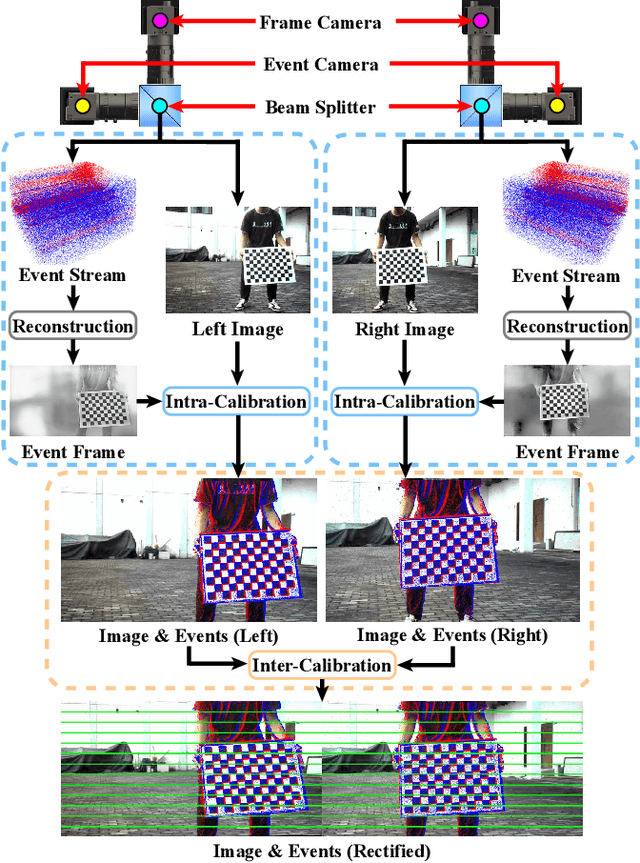Luxin Yan
Detection-Friendly Nonuniformity Correction: A Union Framework for Infrared UAVTarget Detection
Apr 05, 2025Abstract:Infrared unmanned aerial vehicle (UAV) images captured using thermal detectors are often affected by temperature dependent low-frequency nonuniformity, which significantly reduces the contrast of the images. Detecting UAV targets under nonuniform conditions is crucial in UAV surveillance applications. Existing methods typically treat infrared nonuniformity correction (NUC) as a preprocessing step for detection, which leads to suboptimal performance. Balancing the two tasks while enhancing detection beneficial information remains challenging. In this paper, we present a detection-friendly union framework, termed UniCD, that simultaneously addresses both infrared NUC and UAV target detection tasks in an end-to-end manner. We first model NUC as a small number of parameter estimation problem jointly driven by priors and data to generate detection-conducive images. Then, we incorporate a new auxiliary loss with target mask supervision into the backbone of the infrared UAV target detection network to strengthen target features while suppressing the background. To better balance correction and detection, we introduce a detection-guided self-supervised loss to reduce feature discrepancies between the two tasks, thereby enhancing detection robustness to varying nonuniformity levels. Additionally, we construct a new benchmark composed of 50,000 infrared images in various nonuniformity types, multi-scale UAV targets and rich backgrounds with target annotations, called IRBFD. Extensive experiments on IRBFD demonstrate that our UniCD is a robust union framework for NUC and UAV target detection while achieving real-time processing capabilities. Dataset can be available at https://github.com/IVPLaboratory/UniCD.
Divide-and-Conquer: Dual-Hierarchical Optimization for Semantic 4D Gaussian Spatting
Mar 25, 2025Abstract:Semantic 4D Gaussians can be used for reconstructing and understanding dynamic scenes, with temporal variations than static scenes. Directly applying static methods to understand dynamic scenes will fail to capture the temporal features. Few works focus on dynamic scene understanding based on Gaussian Splatting, since once the same update strategy is employed for both dynamic and static parts, regardless of the distinction and interaction between Gaussians, significant artifacts and noise appear. We propose Dual-Hierarchical Optimization (DHO), which consists of Hierarchical Gaussian Flow and Hierarchical Gaussian Guidance in a divide-and-conquer manner. The former implements effective division of static and dynamic rendering and features. The latter helps to mitigate the issue of dynamic foreground rendering distortion in textured complex scenes. Extensive experiments show that our method consistently outperforms the baselines on both synthetic and real-world datasets, and supports various downstream tasks. Project Page: https://sweety-yan.github.io/DHO.
Bridge Frame and Event: Common Spatiotemporal Fusion for High-Dynamic Scene Optical Flow
Mar 11, 2025Abstract:High-dynamic scene optical flow is a challenging task, which suffers spatial blur and temporal discontinuous motion due to large displacement in frame imaging, thus deteriorating the spatiotemporal feature of optical flow. Typically, existing methods mainly introduce event camera to directly fuse the spatiotemporal features between the two modalities. However, this direct fusion is ineffective, since there exists a large gap due to the heterogeneous data representation between frame and event modalities. To address this issue, we explore a common-latent space as an intermediate bridge to mitigate the modality gap. In this work, we propose a novel common spatiotemporal fusion between frame and event modalities for high-dynamic scene optical flow, including visual boundary localization and motion correlation fusion. Specifically, in visual boundary localization, we figure out that frame and event share the similar spatiotemporal gradients, whose similarity distribution is consistent with the extracted boundary distribution. This motivates us to design the common spatiotemporal gradient to constrain the reference boundary localization. In motion correlation fusion, we discover that the frame-based motion possesses spatially dense but temporally discontinuous correlation, while the event-based motion has spatially sparse but temporally continuous correlation. This inspires us to use the reference boundary to guide the complementary motion knowledge fusion between the two modalities. Moreover, common spatiotemporal fusion can not only relieve the cross-modal feature discrepancy, but also make the fusion process interpretable for dense and continuous optical flow. Extensive experiments have been performed to verify the superiority of the proposed method.
DriveEditor: A Unified 3D Information-Guided Framework for Controllable Object Editing in Driving Scenes
Dec 27, 2024Abstract:Vision-centric autonomous driving systems require diverse data for robust training and evaluation, which can be augmented by manipulating object positions and appearances within existing scene captures. While recent advancements in diffusion models have shown promise in video editing, their application to object manipulation in driving scenarios remains challenging due to imprecise positional control and difficulties in preserving high-fidelity object appearances. To address these challenges in position and appearance control, we introduce DriveEditor, a diffusion-based framework for object editing in driving videos. DriveEditor offers a unified framework for comprehensive object editing operations, including repositioning, replacement, deletion, and insertion. These diverse manipulations are all achieved through a shared set of varying inputs, processed by identical position control and appearance maintenance modules. The position control module projects the given 3D bounding box while preserving depth information and hierarchically injects it into the diffusion process, enabling precise control over object position and orientation. The appearance maintenance module preserves consistent attributes with a single reference image by employing a three-tiered approach: low-level detail preservation, high-level semantic maintenance, and the integration of 3D priors from a novel view synthesis model. Extensive qualitative and quantitative evaluations on the nuScenes dataset demonstrate DriveEditor's exceptional fidelity and controllability in generating diverse driving scene edits, as well as its remarkable ability to facilitate downstream tasks.
Adverse Weather Optical Flow: Cumulative Homogeneous-Heterogeneous Adaptation
Sep 25, 2024



Abstract:Optical flow has made great progress in clean scenes, while suffers degradation under adverse weather due to the violation of the brightness constancy and gradient continuity assumptions of optical flow. Typically, existing methods mainly adopt domain adaptation to transfer motion knowledge from clean to degraded domain through one-stage adaptation. However, this direct adaptation is ineffective, since there exists a large gap due to adverse weather and scene style between clean and real degraded domains. Moreover, even within the degraded domain itself, static weather (e.g., fog) and dynamic weather (e.g., rain) have different impacts on optical flow. To address above issues, we explore synthetic degraded domain as an intermediate bridge between clean and real degraded domains, and propose a cumulative homogeneous-heterogeneous adaptation framework for real adverse weather optical flow. Specifically, for clean-degraded transfer, our key insight is that static weather possesses the depth-association homogeneous feature which does not change the intrinsic motion of the scene, while dynamic weather additionally introduces the heterogeneous feature which results in a significant boundary discrepancy in warp errors between clean and degraded domains. For synthetic-real transfer, we figure out that cost volume correlation shares a similar statistical histogram between synthetic and real degraded domains, benefiting to holistically aligning the homogeneous correlation distribution for synthetic-real knowledge distillation. Under this unified framework, the proposed method can progressively and explicitly transfer knowledge from clean scenes to real adverse weather. In addition, we further collect a real adverse weather dataset with manually annotated optical flow labels and perform extensive experiments to verify the superiority of the proposed method.
Perceptual-Distortion Balanced Image Super-Resolution is a Multi-Objective Optimization Problem
Sep 05, 2024Abstract:Training Single-Image Super-Resolution (SISR) models using pixel-based regression losses can achieve high distortion metrics scores (e.g., PSNR and SSIM), but often results in blurry images due to insufficient recovery of high-frequency details. Conversely, using GAN or perceptual losses can produce sharp images with high perceptual metric scores (e.g., LPIPS), but may introduce artifacts and incorrect textures. Balancing these two types of losses can help achieve a trade-off between distortion and perception, but the challenge lies in tuning the loss function weights. To address this issue, we propose a novel method that incorporates Multi-Objective Optimization (MOO) into the training process of SISR models to balance perceptual quality and distortion. We conceptualize the relationship between loss weights and image quality assessment (IQA) metrics as black-box objective functions to be optimized within our Multi-Objective Bayesian Optimization Super-Resolution (MOBOSR) framework. This approach automates the hyperparameter tuning process, reduces overall computational cost, and enables the use of numerous loss functions simultaneously. Extensive experiments demonstrate that MOBOSR outperforms state-of-the-art methods in terms of both perceptual quality and distortion, significantly advancing the perception-distortion Pareto frontier. Our work points towards a new direction for future research on balancing perceptual quality and fidelity in nearly all image restoration tasks. The source code and pretrained models are available at: https://github.com/ZhuKeven/MOBOSR.
CoSEC: A Coaxial Stereo Event Camera Dataset for Autonomous Driving
Aug 16, 2024



Abstract:Conventional frame camera is the mainstream sensor of the autonomous driving scene perception, while it is limited in adverse conditions, such as low light. Event camera with high dynamic range has been applied in assisting frame camera for the multimodal fusion, which relies heavily on the pixel-level spatial alignment between various modalities. Typically, existing multimodal datasets mainly place event and frame cameras in parallel and directly align them spatially via warping operation. However, this parallel strategy is less effective for multimodal fusion, since the large disparity exacerbates spatial misalignment due to the large event-frame baseline. We argue that baseline minimization can reduce alignment error between event and frame cameras. In this work, we introduce hybrid coaxial event-frame devices to build the multimodal system, and propose a coaxial stereo event camera (CoSEC) dataset for autonomous driving. As for the multimodal system, we first utilize the microcontroller to achieve time synchronization, and then spatially calibrate different sensors, where we perform intra- and inter-calibration of stereo coaxial devices. As for the multimodal dataset, we filter LiDAR point clouds to generate depth and optical flow labels using reference depth, which is further improved by fusing aligned event and frame data in nighttime conditions. With the help of the coaxial device, the proposed dataset can promote the all-day pixel-level multimodal fusion. Moreover, we also conduct experiments to demonstrate that the proposed dataset can improve the performance and generalization of the multimodal fusion.
Long-range Turbulence Mitigation: A Large-scale Dataset and A Coarse-to-fine Framework
Jul 11, 2024Abstract:Long-range imaging inevitably suffers from atmospheric turbulence with severe geometric distortions due to random refraction of light. The further the distance, the more severe the disturbance. Despite existing research has achieved great progress in tackling short-range turbulence, there is less attention paid to long-range turbulence with significant distortions. To address this dilemma and advance the field, we construct a large-scale real long-range atmospheric turbulence dataset (RLR-AT), including 1500 turbulence sequences spanning distances from 1 Km to 13 Km. The advantages of RLR-AT compared to existing ones: turbulence with longer-distances and higher-diversity, scenes with greater-variety and larger-scale. Moreover, most existing work adopts either registration-based or decomposition-based methods to address distortions through one-step mitigation. However, they fail to effectively handle long-range turbulence due to its significant pixel displacements. In this work, we propose a coarse-to-fine framework to handle severe distortions, which cooperates dynamic turbulence and static background priors (CDSP). On the one hand, we discover the pixel motion statistical prior of turbulence, and propose a frequency-aware reference frame for better large-scale distortion registration, greatly reducing the burden of refinement. On the other hand, we take advantage of the static prior of background, and propose a subspace-based low-rank tensor refinement model to eliminate the misalignments inevitably left by registration while well preserving details. The dynamic and static priors complement to each other, facilitating us to progressively mitigate long-range turbulence with severe distortions. Extensive experiments demonstrate that the proposed method outperforms SOTA methods on different datasets.
UniAnimate: Taming Unified Video Diffusion Models for Consistent Human Image Animation
Jun 03, 2024



Abstract:Recent diffusion-based human image animation techniques have demonstrated impressive success in synthesizing videos that faithfully follow a given reference identity and a sequence of desired movement poses. Despite this, there are still two limitations: i) an extra reference model is required to align the identity image with the main video branch, which significantly increases the optimization burden and model parameters; ii) the generated video is usually short in time (e.g., 24 frames), hampering practical applications. To address these shortcomings, we present a UniAnimate framework to enable efficient and long-term human video generation. First, to reduce the optimization difficulty and ensure temporal coherence, we map the reference image along with the posture guidance and noise video into a common feature space by incorporating a unified video diffusion model. Second, we propose a unified noise input that supports random noised input as well as first frame conditioned input, which enhances the ability to generate long-term video. Finally, to further efficiently handle long sequences, we explore an alternative temporal modeling architecture based on state space model to replace the original computation-consuming temporal Transformer. Extensive experimental results indicate that UniAnimate achieves superior synthesis results over existing state-of-the-art counterparts in both quantitative and qualitative evaluations. Notably, UniAnimate can even generate highly consistent one-minute videos by iteratively employing the first frame conditioning strategy. Code and models will be publicly available. Project page: https://unianimate.github.io/.
LED: A Large-scale Real-world Paired Dataset for Event Camera Denoising
May 30, 2024



Abstract:Event camera has significant advantages in capturing dynamic scene information while being prone to noise interference, particularly in challenging conditions like low threshold and low illumination. However, most existing research focuses on gentle situations, hindering event camera applications in realistic complex scenarios. To tackle this limitation and advance the field, we construct a new paired real-world event denoising dataset (LED), including 3K sequences with 18K seconds of high-resolution (1200*680) event streams and showing three notable distinctions compared to others: diverse noise levels and scenes, larger-scale with high-resolution, and high-quality GT. Specifically, it contains stepped parameters and varying illumination with diverse scenarios. Moreover, based on the property of noise events inconsistency and signal events consistency, we propose a novel effective denoising framework(DED) using homogeneous dual events to generate the GT with better separating noise from the raw. Furthermore, we design a bio-inspired baseline leveraging Leaky-Integrate-and-Fire (LIF) neurons with dynamic thresholds to realize accurate denoising. The experimental results demonstrate that the remarkable performance of the proposed approach on different datasets.The dataset and code are at https://github.com/Yee-Sing/led.
 Add to Chrome
Add to Chrome Add to Firefox
Add to Firefox Add to Edge
Add to Edge